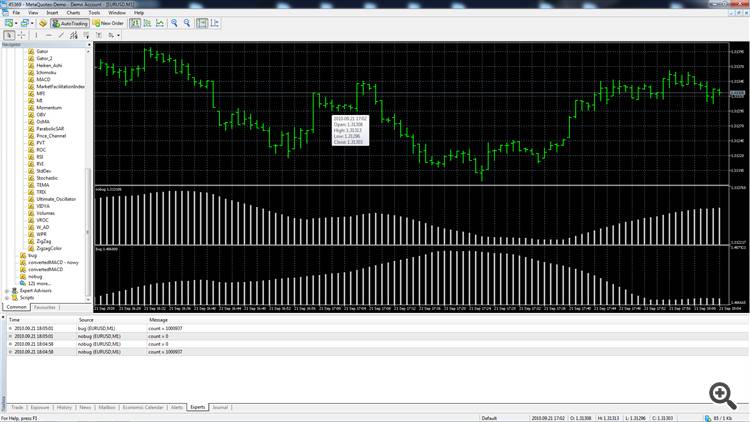I'm sorry, but that's not true. This results in INVERTED macd (inversion in the whole domain of all bars).
But regardless, when count == 1, everything still changes to one weird value.
The "nobug" chart uses (only) CopyBuffer; the "bug" chart uses this for.
Without for, ie MacdBuffer[rates_total-1] = buf[0], it just shows, for every tick, another bar from the end. No difference.
(note: there was no count == 1 value, so no weird one-value everywhere... yet)
@ hasayama: You are right - it's redundant. But the problem still persists.
From Help
"The function can be applied only to dynamic arrays. Please note that you can't change the size for dynamic arrays set as indicator buffers by the function SetIndexBuffer(). "
They are supposed to automatically resize themselves...
- www.mql5.com
Then my suggestion is not an option.
Any way, array must have size before you try to write data into it. Otherwise you'll get an unpredictable result.
"Solved". It seems that all indicator buffers are cleared after each new tick.
This is in contrast to mql4.
Now, it's not a bug if this is written in the manual and by design - I didn't see it, but I may have missed it. Regardless, old mql4 way was better. What's the point in erasing old data? I know that when resizing reallocations may occur, but old data should be copied...
#property copyright ""
#property link ""
#property version "1.00"
#property indicator_separate_window
#property indicator_buffers 1
#property indicator_plots 1
#property indicator_color1 Silver
#property indicator_width1 2
double MacdBuffer[];
int handle;
int OnInit()
{
SetIndexBuffer(0,MacdBuffer,INDICATOR_DATA);
PlotIndexSetInteger(0, PLOT_DRAW_TYPE, DRAW_HISTOGRAM);
handle=iMA(NULL,0,26,0,MODE_EMA,PRICE_CLOSE);
return(0);
}
double x[];
int OnCalculate(const int rates_total,
const int prev_calculated,
const datetime& time[],
const double& open[],
const double& high[],
const double& low[],
const double& close[],
const long& tick_volume[],
const long& volume[],
const int& spread[])
{
int count = rates_total - prev_calculated;
Print("count = ", count);
for(int i = 0; i < ArraySize(x); i++) MacdBuffer[i+count] = x[i];
ArrayResize(x, rates_total);
double buf[];
ArrayResize(buf, count);
CopyBuffer(handle, 0, 0, count, buf);
for(int i = 0; i < count; i++) MacdBuffer[i] = buf[i];
for(int i = 0; i < ArraySize(x); i++) x[i] = MacdBuffer[i];
return(rates_total);
}
- www.mql5.com
"Solved". It seems that all indicator buffers are cleared after each new tick.
This is in contrast to mql4.
Now, it's not a bug if this is written in the manual and by design - I didn't see it, but I may have missed it. Regardless, old mql4 way was better. What's the point in erasing old data? I know that when resizing reallocations may occur, but old data should be copied...
#property copyright ""
#property link ""
#property version "1.00"
#property indicator_separate_window
#property indicator_buffers 1
#property indicator_plots 1
#property indicator_color1 Silver
#property indicator_width1 2
double MacdBuffer[];
int handle;
int OnInit()
{
SetIndexBuffer(0,MacdBuffer,INDICATOR_DATA);
PlotIndexSetInteger(0, PLOT_DRAW_TYPE, DRAW_HISTOGRAM);
handle=iMA(NULL,0,26,0,MODE_EMA,PRICE_CLOSE);
return(0);
}
double x[];
int OnCalculate(const int rates_total,
const int prev_calculated,
const datetime& time[],
const double& open[],
const double& high[],
const double& low[],
const double& close[],
const long& tick_volume[],
const long& volume[],
const int& spread[])
{
int count = rates_total - prev_calculated;
Print("count = ", count);
for(int i = 0; i < ArraySize(x); i++) MacdBuffer[i+count] = x[i];
ArrayResize(x, rates_total);
double buf[];
ArrayResize(buf, count);
CopyBuffer(handle, 0, 0, count, buf);
for(int i = 0; i < count; i++) MacdBuffer[i] = buf[i];
for(int i = 0; i < ArraySize(x); i++) x[i] = MacdBuffer[i];
return(rates_total);
}
It's the only code in all internet that works to use other indicators to make your own indicator (MT5). This code is gold, but some times it returns "array out of range" in this part:
for(int i = 0; i < ArraySize(x); i++) MacdBuffer[i+count] = x[i];
MacdBuffer out of range. I am trying to figure out what is the problem but I'm not geting success. Any Sugestions?
- Free trading apps
- Over 8,000 signals for copying
- Economic news for exploring financial markets
You agree to website policy and terms of use

#property link ""
#property version "1.00"
#property indicator_separate_window
#property indicator_buffers 1
#property indicator_plots 1
#property indicator_color1 Silver
#property indicator_width1 2
int handle;
{
SetIndexBuffer(0,MacdBuffer,INDICATOR_DATA);
PlotIndexSetInteger(0, PLOT_DRAW_TYPE, DRAW_HISTOGRAM);
handle=iMA(NULL,0,26,0,MODE_EMA,PRICE_CLOSE);
return(0);
}
int OnCalculate(const int rates_total,
const int prev_calculated,
const datetime& time[],
const double& open[],
const double& high[],
const double& low[],
const double& close[],
const long& tick_volume[],
const long& volume[],
const int& spread[])
{
int count = rates_total - prev_calculated;
Print("count = ", count);
//bug start - the error is present when count == 1
double buf[];
ArrayResize(buf, count);
CopyBuffer(handle, 0, 0, count, buf);
for(int i = 0; i < count; i++) MacdBuffer[i] = buf[i];
//bug end
//CopyBuffer(handle, 0, 0, count, MacdBuffer); // <--- WORKS
return(rates_total);
}
When count == 1, suddenly ALL displayed values of MacdBuffer are some completely bogus value (the same).
However, when CopyBuffer is used, everything works perfectly, even when count == 1.
This is just a proof of concept of code; I know intermediate buffer is redundant here. I found it while writing a custom indicator
Bug present
Bug not present